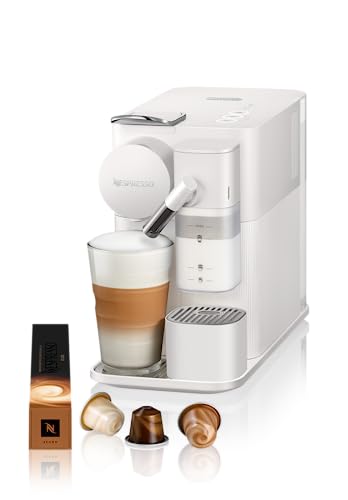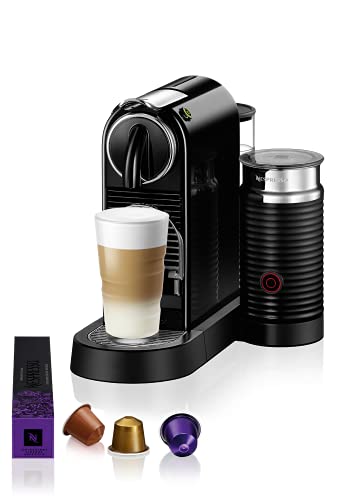Nine Things That Your Parent Taught You About Nespresso Coffeee Machin…
페이지 정보

본문
 Nespresso Coffee - The Essenza Mini
Nespresso Coffee - The Essenza Mini The Essenza Mini is compact, affordable and very user-friendly. It doesn't have features like water tank or a removable drip tray to stay compact, but it does make excellent espresso and lungo.
The Essenza Mini is compact, affordable and very user-friendly. It doesn't have features like water tank or a removable drip tray to stay compact, but it does make excellent espresso and lungo.It operates by piercing capsules, and pumping hot water under pressure to make different espresso and coffee sizes, like the 1.35-ounce espresso, 2.7-ounce double espresso, 5-ounce gran lungo or 14-ounce alto. It can also be used with a stand-alone milk frother.
Capsules
With the Nespresso system you can brew a cup of coffee with the press of the button. You can choose between a single-serving cup or a larger size, and each capsule is filled with the right amount of coffee beans to achieve the desired strength. You can also add some milk powder to make a cappuccino, latte macchiato or other drinks. The capsules are constructed of completely biodegradable materials and can be recycled or disposed in a way that is guilt-free.
The pods are made from aluminium which allows them to withstand the pressure of the machine. The pods are hermetically sealed and can't be tampered with. The coffee grounds stay fresh, safe from oxygen and moisture. Nestle's sustainability goals are aligned with the fact that aluminium is completely recyclable.
However this system isn't without its flaws. For one the machines are costly to buy and operate. Additionally, the capsules are expensive to purchase, and they must be replaced frequently. The machines can also only be used with capsules made by Nespresso. This has led to a number of lawsuits between Nestle and third-party companies which use the exact extraction method and ingredients as Nespresso.
Despite these drawbacks, the Nespresso system offers many advantages that include high-quality coffee and environmental sustainability. It is an excellent alternative to regular coffee and tea bags, and it comes with a much higher extraction rate than other single-serve systems. In fact, a single capsule can yield up to 14 ounces espresso-style coffee.
The first capsule was designed in 1976, and then patented in 1978. Its main features include an cone of aluminum foil, a flat top with an elongated recess that the machine injects hot water, and a narrow opening inside the base, which is punctured from both sides. The machine spins the capsule at 7000 rpm to infuse the coffee with water, resulting in an extremely thick crema.
Water
When you use a Nespresso machine, it's crucial to have water of high-quality. This is crucial for consistency, but also for flavor and texture. It is recommended to make sure to use "filtered" water or "spring water," and avoid tap water or distillate water.
In our laboratory tests, we've discovered that Nespresso machines that use high-quality, softened water make more delicious espressos and lungos than machines that use hard water. This is because hard water causes calcium deposits, as well as other issues which affect the flavor of your coffee.
In each cup of coffee, the Nespresso machine is able to take in and then pumps out hot water at high pressure. This process is known as extraction. The duration, temperature and pressure of the extraction process determines its taste and intensity.
The Original machines pierce and then the capsule and pump it up, whereas the Vertuo models read barcodes that are printed on the capsules to determine how much water is required for a particular kind of espresso. The Vertuo machines can make six different sizes of drinks including espressos as well as macchiatos made of latte with or without foam.
All the machines in the Nespresso range provide 19 bars of pressure. Some of the more expensive models also brew cappuccinos as well as macchiatos with latte and some offer the option of making cold coffee.
Inissia machines and U-series machines are small making it easy to place them in small areas. The Nespresso Pixie is another compact option, with a built-in milk frother. It can be paired with Nespresso's app to get customized recipes and reorder capsules. Nespresso is an excellent choice for those who want to reduce their footprint on the environment while supporting the company's sustainability initiatives.
Temperature
Nespresso machines are more sophisticated than your typical coffee maker, but they are designed to be quick and easy to use. They work very quickly and take only about a minute to prepare each capsule. They're also quite efficient. In contrast to traditional drip coffee makers, which consume more electricity per cup of coffee, Nespresso machines only use a small amount of power to brew each capsule.
Most Nespresso coffeee machine are designed for espresso-based drinks, but some models include milk frothers that can be used to make cappuccinos or lattes. Some models have a dedicated capsule container that can hold up 12 capsules at once. This makes it simple to recycle.
The Nespresso brand is backed by a variety of well-known kitchen equipment makers including Krups, DeLonghi and Breville Nespresso Vertuo Next - Matte Black Machine. However the majority of machines are made by Eugster/Frismag which is a Swiss company that is among the biggest coffee machine manufacturers in the world. This has resulted in criticism of Eugster/Frismag for using patents and other methods similar to those employed by printer manufacturers to create lock-in for vendors.
Pressure
In order to make the best possible espresso, you need to maintain a consistent pressure throughout the extraction process. This is known as "pressure profiling." Pressure profiling entails adjusting the amount of pressure that is applied to the coffee grounds to ensure a perfect extraction and enhance the flavor. This method is possible through the use of different espresso machines, including Nespresso coffee makers.
There are a number of different ways espresso machines can alter the pressure during extraction. A balanced bypass regulates water pressure to a set value, usually 9 bar, regardless of the inlet. This is a simple and effective method that ensures that all espresso groups have the same pressure during the extraction process.
A control knob or lever can be used to manually adjust pressure. This is a more complex method, but it does provide more flexibility and control. It is important to note that manual pressure regulation can cause unsatisfactory results, therefore it requires a high degree of expertise and focus.
In addition, certain espresso machines utilize an electronic pump that adjusts the pressure in accordance with the temperature of the ground and the type of coffee being used. This is a more advanced system, but it can provide more consistent results than other types of espresso machines.
Nespresso has a range of machines which can be used to create espresso, lungo drinks, and some of them can also froth milk. The Nespresso Inissia makes a great machine for baristas at home. It can make 7 to 9 espressos simultaneously and comes with an ice tank that holds 33 ounces. It has buttons that allow you to choose various sizes of drinks, and a capsule tray that can hold up to nine pods. The Nespresso Vertuo Next was designed to be a versatile machine. It has 11 different temperatures for milk and 8 different milk textures. It also comes with a large stainless steel milk frother wand as well as an insulated container that can hold up to 18 ounces of used capsules.
Cleaning
Every time you use a Nespresso it creates limescale and mineral deposits. These residues can mix with your coffee, which can cause it to taste unpleasant. To avoid this from happening, it's important to regularly clean your Nespresso machine and its parts. A thorough cleaning should include washing and descaling the removable parts, like the drip tray and capsule container. A regular wash with fresh water can also help prevent mineral buildup and improve the flavor.
De-scaling solutions can help remove mineral deposits from your machine. These products are available in most coffee and appliance stores. Alternately, you can try using vinegar. This versatile cleaner won't harm your machine, however it may take longer for the minerals to dissolve than a descaling solution.
If you decide to use vinegar, take out the coffee pods first before you empty the reservoir. Then, drain the remainder of the water in the tank and any built-in water filters. Pour the vinegar in and run a cycle without the coffee pod so that it can pass through the machine. Rinse the machine with clean water, and run several times to make sure that there are no vinegar remnants left.
After you've got your machine cleaned, you can wipe down the exterior and its removable parts. Pay particular attention to crevices and corners where gunk may get caught. You can either wash the removable parts with mild soap in your dishwasher or by hand. Rinse them thoroughly. You should also inspect the seals around your capsule and coffee outlet and replace them as needed to maintain their elasticity and to prevent leaks.
- 이전글Bitcoin News - Not For everybody 24.07.02
- 다음글Radio Taxi Aljarafe tel 653404040 24.07.02
댓글목록
등록된 댓글이 없습니다.
